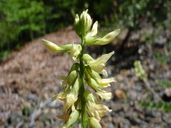Taxon Report
Astragalus umbraticus Sheld.Bald Mountain milk-vetch |
 ©2013 Scot Loring |
Taxon Summary
Astragalus umbraticus, commonly known as Bald Mountain milk-vetch, is a perennial herb in the Fabaceae that is found in California and elsewhere. It occurs within Cismontane woodland, and Lower montane coniferous forest, growing at elevations from 150 to 1250 meters. Astragalus umbraticus is ranked 2B.2, Plants Rare, Threatened, or Endangered in California, But More Common Elsewhere; Moderately threatened in California.Classification
|
Scientific Name: |
Astragalus umbraticus Sheld. |
|
Common Name: |
Bald Mountain milk-vetch |
| Family: | Fabaceae |
| Element Code: | PDFAB0F990 |
| USDA Plants Symbol: | ASUM3 |
|
Synonyms/Other Names: |
|
Ecology and Life History
| Lifeform: | perennial herb |
| Blooming Period: May-Aug | May-Aug |
| Elevation: | 150-1250 (490-4100) |
| General Habitats: | Cismontane woodland, Lower montane coniferous forest |
| Microhabitat: | Roadsides (sometimes) |
| Microhabitat Details: |
Conservation Status
| CA Rare Plant Rank: | 2B.2 |
| Global Rank: | G4 |
|
State Rank: |
S2 |
| State List: | None |
| Fed List: | None |
| Other Status: | |
|
CRPR Changes: |
|
Occurrence Data from the CNDDB
| Total Occurrences: | 36 |
| Element Occurrence Ranks: | |
| Excellent (A) | 4 |
| Good (B) | 10 |
| Fair (C) | 8 |
| Poor (D) | 1 |
| None (X) | 1 |
| Unknown (U) | 12 |
| California Endemic: False | |
| California Counties and Islands: Name (Code) | |
| Humboldt (HUM) | |
| Quads: Name (Quad Code) | |
| Bald Hills (4112328), Fish Lake (4112336), French Camp Ridge (4112327), Holter Ridge (4112338), Hupa Mountain (4112317), Johnsons (4112337), Lord-ellis Summit (4012387), Maple Creek (4012377), Showers Mtn. (4012356), Tish Tang Point (4112315), Weitchpec (4112326), Willow Creek (4012386) | |
Threat List Data from the CNDDB
| Threat List Total: | 7 | |
| EOs with Threat Listed: | Total EOs | % of EOs |
| 24 | 67 % | |
| Logging | 20 | 55% |
| Road/trail construction/maint. | 16 | 44% |
| Other | 9 | 25% |
| Recreational use (non-ORV) | 1 | 2% |
| Non-native plant impacts | 1 | 2% |
| Wood cutting or brush clearing | 1 | 2% |
| Foot traffic/trampling | 1 | 2% |
Selected References
| Astragalus umbraticus profile for potential Species of Conservation Concern evaluation (2018) |
Citation
California Native Plant Society, Rare Plant Program. 2025. Rare Plant Inventory (online edition, v9.5.1). Website https://www.rareplants.cnps.org [accessed 22 December 2025].